Abstract
During recent decades, the elderly population has grown rapidly, and the number of patients with chronic heart-related diseases has exploded. Many of them (e.g., congestive heart failure, some types of arrhythmia) require close medical supervision, imposing a major burden on healthcare resources in most western economies. Telemedicine is clearly emerging as a viable solution for health care to become sustainable by enabling medical monitoring at home without direct professional help, which would greatly reduce assistance costs. Specifically, continuous or frequent arterial blood pressure (ABP) and electrocardiogram (ECG) monitoring are important tools in the follow-up of many of these patients. A multipurpose (e.g. ABP and ECG) monitoring device that requires no medical assistance is highly desirable and would be of great value to patients. One such solution is presented and validated in this work. This paper presents the details of the proposed remote heart self-monitoring system, the testing procedure, and test results.
1. Introduction
A clear trend of population aging has been emerging in developed nations over recent decades, and recently, it has been shown to be accelerating. This trend poses a challenge that will impact our societies in the long term by bringing about profound changes, especially related to economic sustainability due to the enormous resources required to provide the necessary care for older adults. The number of people over 65 is growing much more rapidly than any other population segment, partly due to very low birth rates which are inverting our population pyramid, and even the dynamics of most developed economies. According to the World Health Organization (WHO), this trend has been identified as one of the biggest challenges facing our society [1] which needs to be addressed so that the necessary services can be provided at a manageable cost [2].
Policy makers have noticed this situation and are making great efforts to support initiatives that create new services for the older population based on technological solutions that promote their independence and provide new intelligent functionalities to help them in terms of their daily living needs and health issues.
The elderly are the most prone population group to cardiovascular diseases (CVDs) such as heart attacks, strokes, and arrhythmias. Each year, 17.9 million people die from CVDs (31% of deaths worldwide), with more than 75% of these deaths being due to heart attacks and strokes [3]. Frequent cardiac monitoring at home can help to identify CVDs and prevent future cardiovascular problems; even the risk of death can be predicted with an electrocardiogram (ECG) [4]. To that end, telemedicine devices operated by the patients themselves from their own homes are a great solution, since they do not require the assistance of medical professionals.
A traditional, medical-grade ECG is obtained by attaching electrodes (between 3 and 10 of them) to specific points of the skin around the chest [5,6]; it is typically carried out and analyzed by medical personnel with the necessary knowledge and experience. This type of ECG is cumbersome and impractical for older people to use themselves. This paper presents the VitalMob telemedicine system for heart monitoring that was developed as part of the VitalMob Project (see “Funding”, right after Section 6). The paper mainly focuses on the VM1, a portable device, and its companion smartphone app. The device is capable of recording high quality ECG signals as well as measuring blood pressure. The VM1 is controlled via a Bluetooth LE connection to a smartphone app that also guides the user through the multiple steps of the measuring process. The device and app were both designed for maximum ease of use so that any older person could use it without external aid. If assistance were necessary, a relative or friend would be able to help without any previous training.
The ECG signal can be visualized during the measurement in real time by the user, who can decide whether to upload the data to the cloud after recording it, or to repeat the process if something went wrong. Once in the cloud, the data is analyzed by algorithms that look for potential problems and anomalies (e.g., arrhythmias). If anything, unusual is detected, the doctor is warned so that he/she can inspect the recorded data through any internet-capable device, visually determine whether it is a real problem, and if so, decide how to proceed.
The paper is organized as follows. First, existing technologies are presented and compared to our device, the VM1. Then, in Section 3, an overview of the overall telemedicine system architecture is described, followed by a deep and detailed description of the VM1, a summary of the companion smartphone app, and an overview of the remote e-health platform. Section 4 presents some results from real ECGs that were directly obtained from the VM1 and compared side-by-side with simultaneous ECG recordings obtained using a medical-grade system. The last section is devoted to the presentation of the main conclusions of this and future work.
2. State of the Art
The VitalMob system scope is the acquisition of two highly valuable medical parameters related to heart health: Electro Cardio Gram (ECG) and Arterial Blood Pressure (ABP). The two main categories of arterial blood pressure measurement techniques are called invasive and non-invasive [7]. Invasive techniques are very accurate, but require medical intervention to place a cannula needle in an artery. Thus, they are mostly used for hospitalized and critically ill patients. On the other hand, non-invasive techniques are much quicker and simpler to use, do not require any expertise, and present no difficulties for end users, who can make the measurements by themselves. Automatic blood pressure monitors are very common nowadays and are well-known, even for personal use by individuals of any age. Many different models are cheaply and widely available on the market [8,9]. These devices are usually very easy to operate, sometimes allow data to be stored digitally, and can even be use a mobile app for an interface [10,11]. The VM1 integrates a cuff-based blood pressure measurement system as part of its functionality. The cuff is connected to the main device chassis and can be used in a straightforward and safe way.
ECGs are crucial for monitoring heart and vascular health. A standard 12-lead ECG is used for clinical monitoring [12], but this is impractical for cases where portability and simplicity are important. The first portable ECG monitors were mainly for medical ambulatory use, and were generally handled by professionals. That’s why this type of devices tend to be more complex to operate; however, in recent years, TIC advances are bringing this technology closer to end users.
Nowadays, two-electrode ECG monitoring is widely accepted for ECG portable devices [13]. There are many different commercial examples such as the AliveCor system [14], which consists of a pocket device for ECG measurements which is capable of obtaining the heart rhythm and detecting atrial fibrillation. Similarly, the Chekme Lite device from Viatom [15] is a portable ECG recorder with a pulse oxymeter. Other examples are the SnapECG a handheld ECG recorder [16] and the QardioCore ECG monitor [17], a wearable ECG monitor. Most are Holter type, stand-alone devices and are not capable of sending the acquired data to any external server in real time. In contrast, the VM1 is able to send the acquired ECG and blood pressure data to a remote e-health platform right after a measurement is taken for its immediate automatic analysis and search of potential cardiac problems. If any potential problem is detected, the doctor will be automatically warned for visual inspection of the ECG signal and diagnostic.
The VM1 can provide up to 4 ECG electrodes, which is an advantage over most existing solutions that can only provide two.
Recent publications on ECG monitoring deal with data processing and management (such as computational techniques, data analysis, compression techniques, etc.) [18,19,20,21], as well as new materials for ECG sensors [22,23] and miniaturization for portability [24]. Data processing of the Vitalmob system is implemented in a remote e-health platform, including an initial preprocessing and signal conditioning filtering, followed by a beat detection algorithm and a QRS-wave analysis.
3. System Architecture
The VM1 portable monitor has been designed with a very ergonomic oval and wide shape that includes two separate areas for placing the hands over two ECG electrodes. The VM1 is a sensor device for ECG recording and ABP measurement, and is connected via Bluetooth to a mobile application that provides the user interface, carries out some data processing and storage and displays the acquired data in real time during the measurement process. The application also acts as a gateway, through which the acquired data can be sent to a remote cloud platform for automatic medical analysis. Figure 1 depicts the complete system.
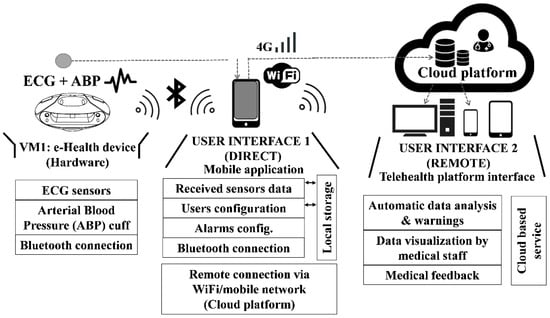
Figure 1.
System architecture.
3.1. VM1, the e-Health Device (Hardware)
The VM1 was designed to be highly ergonomic and easy to use, so that any cardiac patient (including older people) could use it without assistance. The VM1 includes a portable blood pressure cuff, an air compressor, two ECG electrodes, and other hardware elements (see Figure 2), specifically a battery, a Bluetooth communication module, and a processor, which orchestrates the rest of the system elements and the communication with the mobile application. This app stores the data of the VM1 measurements, and controls the VM1 itself through the Bluetooth communication interface.
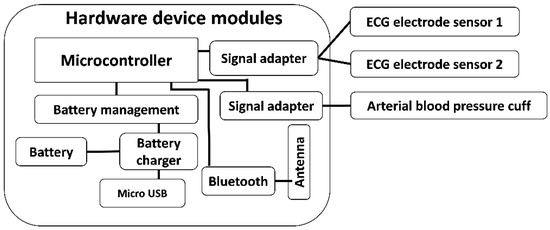
Figure 2.
Hardware modules.
The VM1 ECG monitor (see Figure 3) includes two metallic electrodes located on top of the apparatus. The user can place both hands on the electrodes, or hold the device while pressuring the electrodes for increased performance. The user controls the device from an application previously installed in a mobile device. The smartphone can be placed on a dedicated surface located between both hands. This surface separates both hands to prevent contact, since this would corrupt the ECG signal. The VM1 uses Bluetooth 4.0.
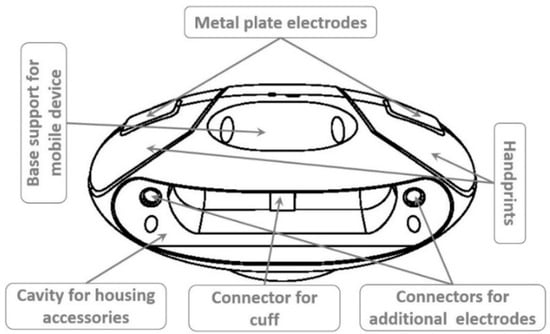
Figure 3.
Portable and ergonomic design concept description.
A careful and through design process was carried out achieving innovative user-friendliness and features. The designed device has an oval shape and two metal plates electrodes are placed in the upper lateral areas of the device for ECG measurements. The electrodes are surrounded by handprints that indicate how to place the hands on the device. The oval shape is ergonomic and increases comfort of use, whereas the handprints reduce the possibilities of wrong measurements, and its much simpler to use than other devices that require the electrodes to be placed in specific points in the chest. The device can be placed on the user's lap or on a table; it can also be hold and moved with one hand.
The VM1’s bottom surface is flat so as to provide good stability on almost any surface (for instance a table, bed or user’s lap). A holding base on which to place the smartphone is situated in the center upper part of the VM1, so that the app information can be easily seen and controlled during the ECG and ABP data acquisition. In any case, the smartphone could be placed in another nearby location (such as a table), or even be controlled by another person (as long as the device and the smartphone are within the range of the Bluetooth connection).
The VM1 design includes a large cavity in the middle part of the structure, under the smartphone holder. This cavity has been designed to house some additional measurement elements, that include additional connectors to two optional wired electrodes and their cables for direct skin contact, as well as the cuff for blood pressure measurement.
The VM1 has two distinct modes of operation. In the first one, only two electrodes are used, and ECG recording can be done either from the metal electrodes on top of the device, or from the two wired electrodes. In the second mode, the additional wired electrodes can add up to the existing ones providing a total of four. This is useful for some pathologies that need to analyze a greater number of leads.
The user can place the wired electrodes on the chest in order to acquire more precise signals. Wet electrodes can be used for better ECG signal quality. This method is preferred for older people with hand tremors, since a lot of noise is introduced in the measurements if hands are not static. This noise is eliminated by placing the wired electrodes at the same points that traditional chest ECG. Moreover, in this case the data wave is identical to a traditional ECG. Specifically, as shown in Figure 3, the two additional connectors for electrodes can be found on the sides of the cavity, while the connector for the blood pressure cuff is located in the centre.
The VM1 external oval-shaped case houses all electronics and hardware modules of the system and includes a smartphone holder. The VM1 is an ergonomic and versatile device that can be used by almost any user. It only requires an external smartphone that runs the VitalMob app, which has been carefully designed to provide a very user-friendly and simple interface. The case has been designed using a set of standard CAD design software tools (such as Rhinoceros® or 3D Studio Max®) and has been made using precise state-of-the-art 3D printers (Figure 4).

Figure 4.
CAD prototype designed (a) and final 3D printed prototype assembled (b).
3.2. VitalMob App
The smartphone app is a fundamental part of the VitalMob system that provides users control of the device, and data storage and visualization. It also sends data to a remote e-health platform. The elderly are a key market, and therefore, it is necessary to take into account their limitations. For example, they usually are not familiar with this type of applications and devices.
The app includes different functionalities, most of them are transparent to the user to facilitate its use. The process starts with a common login prompt, and continues with a guided measurement procedure (see Figure 5) until the ECG or ABP is acquired. After the measurement, the data can be sent to an e-health platform for remote automated analysis. Figure 5 shows a block diagram of the app functionalities and its control flow. The application interface design considered the elderly needs to make it very straightforward and easy-to-use. Some app screen designs are shown in Figure 6.
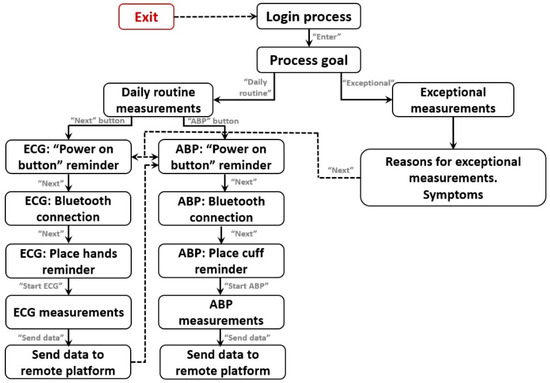
Figure 5.
App flow block diagram.
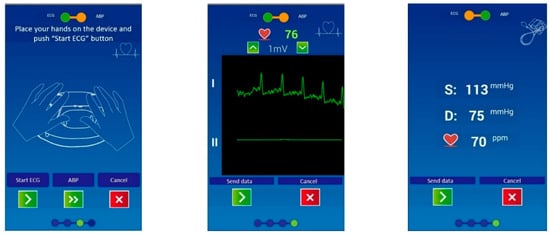
Figure 6.
App interface design.
3.3. Remote e-Health Platform
A remote e-health platform has been developed to store and automatically analyze the data sent by the VM1. Data is made available to the doctor and patient. ECG and arterial blood pressure can be analyzed over time, which is crucial for cardiac patients and the goals of the VitalMob project. This paper is mainly focused on the VM1 portable device, its hardware aspects (Section 3.1) and the smartphone application (Section 3.2). Therefore, a detailed description of the platform (developed by our research partners at Qoolife) falls beyond the scope of this paper [25]. Here we only summarize its main advantages:
- It is a versatile and configurable platform. It includes questionnaires to collect information provided by the patient and provides support for patient assistance requests.
- It is offered as SaaS, so it is cheaper than other custom tools.
- It allows remote monitoring of patients using different tools such as questionnaires and online medical consultations.
- The collected data are easily integrated in a database and available for download in different formats.
- It includes an initial preprocessing and signal conditioning filtering, followed by a beat detection algorithm and a QRS-wave analysis.
4. Tests and Results
The VitalMob system was tested in the Hospital Universitario Virgen de la Arrixaca of Murcia (HUVA), under clinical supervision. The ABP functionality was compared against professional medical equipment with more than 20 users and high precision was demonstrated.
The ECG was recorded with the VM1 for intervals from 1 to 2 min with a total of 24 healthy individuals and 36 outpatients of the Arrhythmia Unit of HUVA. The patients were carefully selected in order to get a subjects of the most frequent rhythm disturbances in the general population. The VM1 ECG data were compared for validation with the data from a medical-grade ECG. Both ECGs were recorded during the same visit to the hospital. Table 1 shows the diagnoses of the participant patients:

Table 1.
Heart rate diagnoses and number of evaluated subjects.
The patients were sitting in a chair in front of a desk during the tests. For older patients, with tremor in their hands, the recorded signals had a high level of noise when the user’s hands were simply placed on top of the electrodes. It was found that better results could be achieved if the VM1 was firmly gripped in such a way that the thumbs were placed on the electrodes and the rest of the fingers under the device. That way a higher pressure could be applied by the user in order to avoid friction between the electrode and the skin in contact, which would generate a significant amount of electrical noise and hide the actual ECG signal.
After reviewing the acquired data by expert cardiologists in daily practice at the above-mentioned hospital, it was concluded that the VM1 could be used for the detection of multiple and relevant cardiac pathologies, including the ones in list above. Even though additional testing would be necessary in order to get a highly accurate diagnosis, it could be used at least to warn the cardiologist, who could them personally review the recorded ECG and decide how to proceed. The recorded signal could be used to identify potential problems through regular measurements at home by the user, instead of having to visit the hospital. Any indications of potential problems could be detected much faster and cheaply than following the traditional approach.
Figure 7 shows some of the performed tests for 2 users, in which two simultaneous signals were acquired simultaneously from the VM1 and from a BIOPAC system [26], so they could be compared side by side as shown. BIOPAC was used since it provides a better way of recording the data for computer-based analysis and comparison against the VM1 results than the regular medical ECG devices at the hospital. The most evident result is the perfect synchronization among R peaks, which verifies that the VM1 can be used for the analysis of rhythm and detection of its anomalies, such as arrhythmias, extrasystoles and tachycardia. Similarly, the width of the QRS pulse can be estimated with the VM1 and follows a high correlation and accuracy with the BIOPAC-obtained signal.
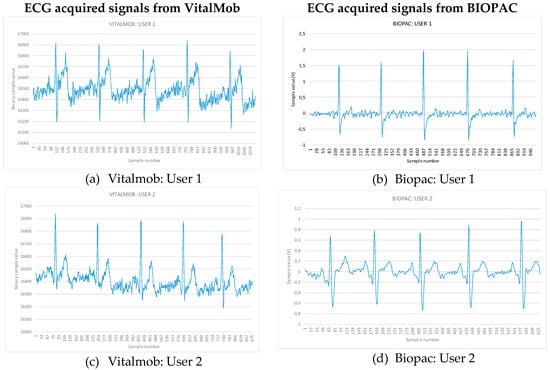
Figure 7.
VitalMob and Biopac ECG samples acquired.
It should be noted that the BIOPAC system is widely used in the bio-signal research field [27,28,29]. The BIOPAC physiological measurement system, BIOPAC MP150 was used to obtain ECG data. Specifically, the electrocardiogram amplifier module (ECG100C) was connected to the BIOPAC system to record the ECG signal. A three-lead configuration was used for collecting ECG data (the white lead was connected to SHIELD and VIN- on the ECG100C module, the Red lead was connected to SHIELD and VIN+ and the Black lead was connected to GND).
5. Conclusions
This paper presents an overview of a novel telemedicine solution for in-home heart monitoring developed in a research project titled VitalMob. Its main objective was to create a very simple, high quality and easy-to-use portable ECG and ABP monitor with cloud-based automatic analysis within a complete e-health platform that could be used by people with low technical skills and no medical experience such as older people. This solution contributes to reducing health-related costs through regular self-monitoring at home.
The paper mainly focuses on describing the VM1, a portable device, and its companion smartphone app. A lot of effort has been put in order to make the VM1 highly ergonomic and convenient to use. It is capable of recording high quality ECG signals as well as measuring ABP. The VM1 is controlled via a Bluetooth LE connection by a smartphone app that guides the user through the multiple steps of the measuring process. Device and app were both jointly designed for maximum ease of use, so that any common older person or cardiac patient could use it with no assistance.
The ECG signal can be visualized during measurement in real time by its user, who can decide whether to upload it to the cloud, or to repeat the process if something went wrong. Once in the cloud, data are analyzed by some algorithms that look for potential problems and anomalies (e.g., arrythmias). If any potential problem is detected, the doctor is requested to inspect the data. Any internet-capable device can be used to visually inspect the ECG and confirm if it is a real problem and decide how to proceed.
In the most common mode of ECG recording, the user places her hands over the flat electrodes embedded on the top of the VM1 case. This makes the ECG measurement easier for non-expert users, while providing enough accuracy to identify many common potential problems. If that is the case, then a more complete ECG in the hospital could be prescribed.
Compared to similar solutions, the VitalMob system is the only one that can send ECG and ABP data to the cloud for immediate data analysis in search of potential problems. Moreover, the VM1 is versatile enough to provide three modes of operation: (1) 2 embedded electrodes, (2) 2 wired electrodes and (3) 4 wired electrodes. If the user suffers from hand tremors or if a higher quality or lower noise ECG is required, two optional wired electrodes can be directly placed over the user’s skin instead. These two wired electrodes can add up to the flat electrodes if a 4-electrode ECG were required.
The VM1 was validated in two stages under medical supervision. It was also compared against a very precise reference system for bio-signal analysis (Biopac MP150 and ECG100C modules).
The described portable solution is a clear example of an AAL system that contributes to a more independent and more autonomous lives of the elderly.
6. Future Work
RGB and CETEM’s R&D teams are already working in the last stages of a later project for enhancing the VM1, so that it can be used to estimate other hemodynamic variables that may shed more light on other cardiovascular pathologies such as heart failure.
7. Patents
A patent has resulted from the work reported in this manuscript. Patent number: ES 2 587 789. Patent title: “Portable arterial blood pressure and electrocardiogram measuring device”.
Author Contributions
Conceptualization, J.C. and R.M.; methodology, A.L.B., R.R.; software, J.C.; validation, A.L.B., R.M.; investigation, A.L.B., R.M., R.R. and J.C.; resources, J.C.; writing—original draft preparation, A.L.B.; writing—review and editing, R.M.; project coordination, R.M.
Funding
This research was funded by MINISTERIO DE ECONOMIA Y COMPETITIVIDAD, grant number IPT-2012-1126-300000.
Acknowledgments
We thank all members of the VitalMob consortium for their role in the collaborative development of the research project. VitalMob is a project funded by the Ministerio de Economia y Competitividad inside the Plan Nacional de Investigación Científica, Desarrollo e Innovación Tecnológica 2008–2011.
References
- WHO. Active Ageing: A Policy Framework; WHO: Geneva, Switzerland, 2002. [Google Scholar]
- O’Grady, M.J.; Muldoon, C.; Dragone, M.; Tynan, R.; O’Hare, G.M.P. Towards evolutionary ambient assisted living systems. J. Ambient Intell. Humaniz. Comput. 2010, 1, 15–29. [Google Scholar] [CrossRef]
- World Health Organization. Available online: http://www.who.int/cardiovascular_diseases/en/ (accessed on 18 December 2018).
- Syed, Z.; Stultz, C.M.; Scirica, B.M.; Guttag, J.V. Computationally generated cardiac biomarkers for risk stratification after acute coronary syndrome. Sci. Transl. Med. 2011, 3, 102ra95. [Google Scholar] [CrossRef] [PubMed]
- Lim, Y.G.; Kim, K.K.; Park, S. ECG measurement on a chair without conductive contact. IEEE Trans. Biomed. Eng. 2006, 53, 956–959. [Google Scholar] [PubMed]
- Adib, F.; Mao, H.; Kabelac, Z.; Katabi, D.; Miller, R.C. Smart homes that monitor breathing and heart rate. In Proceedings of the 33rd Annual ACM Conference on Human Factors in Computing Systems, Seoul, Korea, 18–23 April 2015; pp. 837–846. [Google Scholar]
- Pickering, T.G.; Hall, J.E.; Appel, L.J.; Falkner, B.E.; Graves, J.; Hill, M.N.; Jones, D.W.; Kurtz, T.; Sheps, S.G.; Roccella, E.J. Recommendations for blood pressure measurement in humans and experimental animals: part 1: blood pressure measurement in humans: A statement for professionals from the Subcommittee of Professional and Public Education of the American Heart Association Council on High Blood Pressure Research. Circulation 2005, 111, 697–716. [Google Scholar] [PubMed]
- Omron Healthcare. Available online: https://omronhealthcare.com/blood-pressure/ (accessed on 17 December 2018).
- ViveHealth Blood Pressure Monitor. Available online: https://www.vivehealth.com/products/blood-pressure-monitor-cuff (accessed on 17 December 2018).
- QardioArm Blood Pressure Monitor. Available online: https://www.getqardio.com/es/qardioarm-blood-pressure-monitor-iphone-android/ (accessed on 17 December 2018).
- QardioArm Mobile Application. Available online: https://www.getqardio.com/es/qardioapp/ (accessed on 17 December 2018).
- Garvey, J.L. ECG techniques and technologies. Emerg. Med. Clin. 2006, 24, 209–225. [Google Scholar] [CrossRef] [PubMed]
- Ye, C.; Coimbra, M.T.; Kumar, B.V. Investigation of human identification using two-lead electrocardiogram (ECG) signals. In Proceedings of the 2010 Fourth IEEE International Conference on Biometrics: Theory Applications and Systems (BTAS), Washington, DC, USA, 27–29 September 2010; pp. 1–8. [Google Scholar]
- AliveCor ECG Measurement Device. Available online: https://www.alivecor.com/ (accessed on 17 December 2018).
- CheckMe Lite Vital Signs Monitor. Available online: https://www.viatomtech.com/checkme-lite (accessed on 17 December 2018).
- SnapECG Handheld ECG Recorder. Available online: http://www.mhealth365.com/en/product-4.html (accessed on 17 December 2018).
- QardioCore ECG Monitor. Available online: https://store-eu.getqardio.com/products/qardiocore (accessed on 17 December 2018).
- Lyon, A.; Mincholé, A.; Martínez, J.P.; Laguna, P.; Rodriguez, B. Computational techniques for ECG analysis and interpretation in light of their contribution to medical advances. J. R. Soc. Interface 2018, 15, 20170821. [Google Scholar] [CrossRef] [PubMed]
- Shi, B.; Harding, S.; Larsen, P. Analysis of ECG measures of cardiac repolarization in relation to arrhythmic events in an implantable cardioverter defibrillator population. Ann. Noninvasive Electrocardiol. 2017, 22, e12390. [Google Scholar] [CrossRef] [PubMed]
- Pinto, J.R.; Cardoso, J.S.; Lourenço, A.; Carreiras, C. Towards a continuous biometric system based on ECG signals acquired on the steering wheel. Sensors 2017, 17, 2228. [Google Scholar] [CrossRef] [PubMed]
- Elgendi, M.; Mohamed, A.; Ward, R. Efficient ECG Compression and QRS Detection for E-Health Applications. Sci. Rep. 2017, 7, 459. [Google Scholar] [CrossRef] [PubMed]
- Sahar, N.S.; Abdul-Kadir, N.A.; Chan, W.H.; Su, E.L.M.; Harun, F.C. Wireless ECG Circuit on Flexible Material: A Preliminary Study. J. Telecommun. Electr. Comput. Eng. (JTEC) 2018, 10, 43–46. [Google Scholar]
- Fong, E.M.; Chung, W.Y. Mobile cloud-computing-based healthcare service by noncontact ECG monitoring. Sensors 2013, 13, 16451–16473. [Google Scholar] [CrossRef] [PubMed]
- Abuzairi, T.; Matondang, J.S.; Purnamaningsih, R.W.; Basari; Ratnasari, A. Design of portable electrocardiogram device using DSO138. AIP Conf.Proc. 2018, 1933, 040005. [Google Scholar]
- Qoolife Webpage. Available online: https://qoolife.com/?locale=en (accessed on 17 December 2018).
- Biopac System. Available online: https://www.biopac.com/ (accessed on 17 December 2018).
- Kwon, S.; Lee, J.; Chung, G.S.; Park, K.S. Validation of heart rate extraction through an iPhone accelerometer. In Proceedings of the 2011 Annual International Conference of the IEEE Engineering in Medicine and Biology Society, Boston, MA, USA, 30 August–3 September 2011; pp. 5260–5263. [Google Scholar]
- Miao, F.; Cheng, Y.; He, Y.; He, Q.; Li, Y. A wearable context-aware ECG monitoring system integrated with built-in kinematic sensors of the smartphone. Sensors 2015, 15, 11465–11484. [Google Scholar] [CrossRef] [PubMed]
- Kranjec, J.; Beguš, S.; Geršak, G.; Šinkovec, M.; Drnovšek, J.; Hudoklin, D. Design and Clinical Evaluation of a Non-Contact Heart Rate Variability Measuring Device. Sensors 2017, 17, 2637. [Google Scholar] [CrossRef] [PubMed]
© 2019 by the authors. Licensee MDPI, Basel, Switzerland. This article is an open access article distributed under the terms and conditions of the Creative Commons Attribution (CC BY) license (http://creativecommons.org/licenses/by/4.0/).